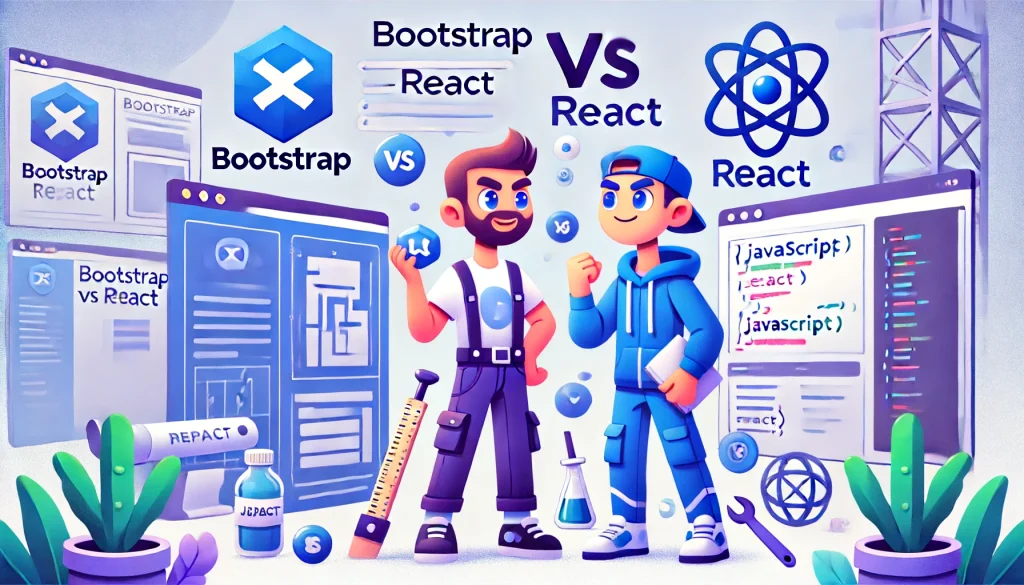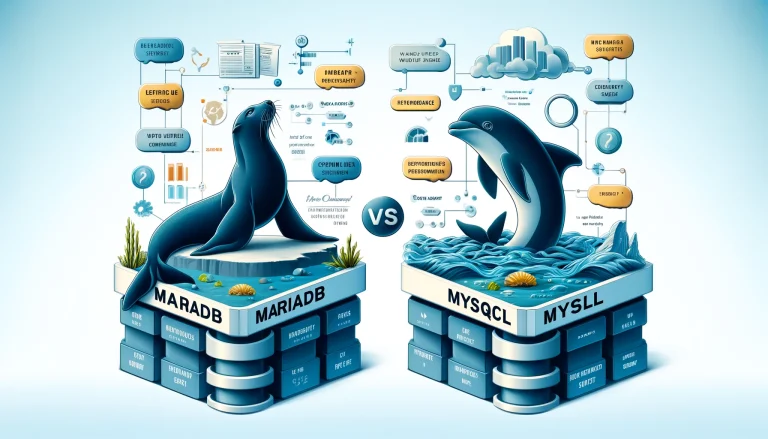Bootstrap vs React: A Comprehensive Comparison
Web development has become increasingly complex with the myriad of frameworks and libraries available. Among these, Bootstrap vs React stand out as two of the most popular choices for developers looking to build responsive and dynamic web applications. While both tools serve different purposes, they are often compared due to their significant influence on the development process. This article provides an in-depth comparison of Bootstrap vs React, highlighting their features, benefits, and ideal use cases.

Table of Contents
Introduction
In the ever-evolving landscape of web development, choosing the right tools can make or break your project. Bootstrap vs React are two prominent names that have garnered a substantial following in the developer community. Understanding their differences and knowing when to use each can significantly enhance your development workflow and end product. This comparison will shed light on various aspects of both technologies, helping you make an informed decision.
Understanding Bootstrap
Bootstrap is a powerful front-end framework originally developed by Twitter. It simplifies the development of responsive, mobile-first websites by providing a comprehensive toolkit of pre-designed components, grid systems, and JavaScript plugins. Its primary aim is to streamline the creation of visually appealing and functional web pages with minimal effort.
Key Features of Bootstrap
Grid System
Bootstrap’s 12-column grid system allows developers to create responsive layouts effortlessly. This flexible system adapts to different screen sizes, ensuring that your website looks great on all devices.
Pre-designed Components
From buttons to navigation bars, Bootstrap offers a wide range of reusable components that can be easily customized. This accelerates the development process, allowing you to build consistent and professional-looking interfaces quickly.
Extensive Documentation
Bootstrap’s documentation is one of its standout features. It provides detailed explanations, examples, and guidelines, making it accessible even for beginners.
Benefits of Using Bootstrap
Rapid Development
Bootstrap’s pre-designed components and grid system enable rapid prototyping and development. This is particularly beneficial for projects with tight deadlines.
Consistency Across Projects
By using Bootstrap, you can ensure a consistent look and feel across different projects. This is crucial for maintaining brand identity and user experience.
Responsive Design
With mobile internet usage surpassing desktop, responsive design is no longer optional. Bootstrap’s mobile-first approach ensures that your site is optimized for all devices.
When to Use Bootstrap
Bootstrap is ideal for projects where speed and consistency are paramount. It’s a great choice for landing pages, marketing sites, and internal dashboards where time-to-market and uniformity are critical.
Understanding React
React, developed by Facebook, is a JavaScript library for building user interfaces. Unlike Bootstrap, which focuses on the front-end design, React is all about building dynamic, stateful, and reusable UI components. It’s known for its performance and flexibility, making it a popular choice for single-page applications (SPAs) and complex web applications.
Key Features of React
Component-Based Architecture
React’s component-based architecture allows developers to build encapsulated components that manage their state. This modular approach promotes reusability and simplifies maintenance.
Virtual DOM
React’s Virtual DOM optimizes rendering performance by updating only the parts of the DOM that have changed. This leads to faster and more efficient updates.
One-Way Data Binding
React uses one-way data binding, which means that data flows in a single direction, making it easier to debug and understand the application state.
Benefits of Using React
High Performance
React’s Virtual DOM ensures high performance and efficient updates, making it suitable for applications that require dynamic data handling.
Flexibility and Scalability
React’s component-based structure makes it highly flexible and scalable. You can build large-scale applications with complex UIs without sacrificing maintainability.
Strong Community Support
React has a vibrant community and a rich ecosystem of libraries and tools, providing ample resources and support for developers.
When to Use React
React is best suited for complex and dynamic web applications where performance and scalability are crucial. It’s an excellent choice for SPAs, e-commerce sites, and applications with heavy user interaction.
Bootstrap vs React: Direct Comparison
While Bootstrap and React serve different purposes, comparing them on key aspects can help clarify their respective strengths and weaknesses.
Ease of Learning and Implementation
Bootstrap is generally easier to learn and implement, especially for beginners. Its extensive documentation and pre-designed components make it accessible. React, on the other hand, has a steeper learning curve due to its component-based architecture and the need to understand JavaScript deeply.
Customization and Flexibility
React offers greater customization and flexibility. Its component-based approach allows developers to create highly personalized and dynamic UIs. Bootstrap, while customizable, is more rigid due to its pre-defined components and styles.
Performance
React generally outperforms Bootstrap in terms of rendering and updates, thanks to the Virtual DOM. For static sites or simple applications, this might not be a significant factor, but for dynamic and data-intensive applications, React’s performance advantage is substantial.
Use Cases
Bootstrap is ideal for quickly developing responsive, visually appealing sites with a consistent design. React is better suited for building complex, interactive web applications that require dynamic data handling and high performance.
Integration of Bootstrap and React
Interestingly, Bootstrap and React can be integrated to leverage the strengths of both. By using React-Bootstrap, developers can utilize Bootstrap’s UI components within a React application. This approach provides the best of both worlds: Bootstrap’s design consistency and React’s dynamic capabilities.
React-Bootstrap
React-Bootstrap is a popular library that replaces Bootstrap’s JavaScript with React components, making it easier to use Bootstrap with React. It provides all the Bootstrap components as React components, allowing for seamless integration.
Benefits of Using React-Bootstrap
Consistency in Design
By using React-Bootstrap, you can maintain Bootstrap’s consistent design system while taking advantage of React’s component-based architecture.
Ease of Use
React-Bootstrap simplifies the integration process, allowing developers to use familiar Bootstrap components within their React applications.
Enhanced Customization
With React-Bootstrap, you can easily customize Bootstrap components using React’s props and state, providing greater flexibility and control over the UI.
Real-World Examples
Bootstrap
- Twitter: As the birthplace of Bootstrap, Twitter extensively uses it for its internal tools and public-facing pages.
- Spotify: Spotify utilizes Bootstrap for its web player, ensuring a responsive and consistent user experience across devices.
React
- Facebook: Being the creator of React, Facebook uses it extensively for its web applications, ensuring high performance and a seamless user experience.
- Netflix: Netflix leverages React to build its high-performance, responsive web interface, handling millions of user interactions smoothly.
Common Challenges and Solutions
Bootstrap
Customization Limitations
While Bootstrap provides a robust set of components, customizing them beyond certain limits can be challenging. To overcome this, developers can use custom CSS or Sass variables to extend Bootstrap’s styles.
React
Steep Learning Curve
React’s learning curve can be daunting for beginners. To mitigate this, developers should start with the basics of JavaScript and gradually move to more complex React concepts, utilizing tutorials and documentation.
FAQs
What is the primary difference between Bootstrap vs React?
Bootstrap is a front-end framework focused on responsive design and pre-designed components, while React is a JavaScript library for building dynamic, stateful UIs with a component-based architecture.
Can Bootstrap vs React be used together?
Yes, Bootstrap and React can be used together through libraries like React-Bootstrap, which allows developers to utilize Bootstrap components within React applications.
Which is better for beginners, Bootstrap or React?
Bootstrap is generally easier for beginners due to its straightforward implementation and extensive documentation. React, while more complex, offers greater flexibility and performance for building dynamic applications.
Is React faster than Bootstrap?
React typically offers better performance due to its Virtual DOM, especially for applications that require frequent updates and dynamic data handling.
When should I use Bootstrap over React?
Use Bootstrap for projects that require quick development of responsive, visually appealing sites with a consistent design. React is better for complex, interactive web applications requiring high performance and scalability.
What are some popular projects built with Bootstrap vs React?
Popular projects built with Bootstrap include Twitter and Spotify, while React powers applications like Facebook and Netflix.
Conclusion
Choosing between Bootstrap vs React ultimately depends on your project requirements and development goals. Bootstrap excels in rapid development of responsive, visually consistent websites, making it a go-to choice for simpler projects and beginners. React, with its component-based architecture and high performance, is better suited for complex, dynamic web applications. By understanding the strengths and limitations of each, you can make an informed decision that aligns with your project needs, ensuring both efficiency and quality in your web development endeavors.






